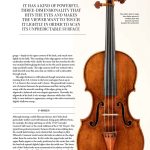The Strad magazine, February 2011 issue: In focus: Annibale Fagnola
Copyright © 2011 Alberto Giordano – The Strad magazine. All rights reserved
MAKER
Annibale Fagnola was born to a farming family in 1866 in Montiglio, a village in the hills of Monferrato, northern Italy. Information about his youth is scarce: it seems he worked as a baker until 1888, then moved to Turin in 1894. Details of his apprenticeship are also unclear. He was apparently guided into violin making by Orazio Roggero, a lawyer and violin collector, who also introduced him to the Turin music world. Around 1895 he began attending Marengo Rinaldi’s workshop in the city, first making guitars and moving on to violins only in 1897–8. He opened his own workshop in 1899.
Fagnola considered himself to be a self-taught maker. But although he worked on his own very soon after taking up violin making, he still collaborated with Rinaldi and was in regular contact with Rinaldi’s assistants, Evasio Guerra and Carlo Giuseppe Oddone. He made instruments based mainly on models from the Turin school.
In his first period (until around 1905), Fagnola produced a number of instruments based on Rocca and Pressenda models which appear as fine copies, sometimes covered with a beautiful, rich, soft red varnish, and which have a slightly antiqued look. He subsequently dedicated himself more to classic Cremonese models, which he considered more suitable for the international exhibitions that he entered in Genoa and Milan in 1906, and in Turin in 1911, where he gained international recognition.
Fagnola trained Riccardo Genovese, Stefano Vittorio Fasciolo and his nephew Anibalotto Fagnola, and he died in Turin in 1939.
STYLE
Fagnola’s instruments show a great personality and a confident touch. His production is consistent and includes violins, violas and cellos made in the new and, especially during the 1920s, a number of antiqued copies of instruments by the Turin makers, always made with enormous care and skill.
INSTRUMENT
This violin, made in 1923, is one of the finest examples of the maker’s later period. It was made on a Giovanni Battista Guadagnini model: it bears a copy of the Guadagnini label of the earlier maker’s Turin period, and it is signed on the lower block ‘Annibale Fagnola fecit Torino 1923’. A patina of dirt covers the interior that appears confidently antiqued, and the linings are deeply mitred in the upper and lower blocks, which are made of willow, quite thick and well rounded.
The archings are cut with extreme care, the scoop of the purfling is gently fluted, and the f-holes are cut straight in the Guadagnini style, with the upper holes slightly chamfered and the lower palettes gently scooped.
The scroll shows the use of a point to mark the centre line. The chamfers are painted black, the pegbox flanks are only slightly rounded, and the throat was left quite unfinished.
The instrument’s varnish is of a rich texture, quite thick but transparent. Fagnola took great care in preparing the wood, and his highly developed antiquing technique can be seen in the chin area of the belly, where the spruce looks perfectly aged and worn.
Still in nearly pristine condition today, the violin has been carefully preserved by the maker’s heirs.
MEASUREMENTS
- Back length 354.5mm
- Stop length 195mm
- Upper bouts 166mm
- Middle bouts 115.5mm
- Lower bouts 205.5mm
The Strad, february 2011




